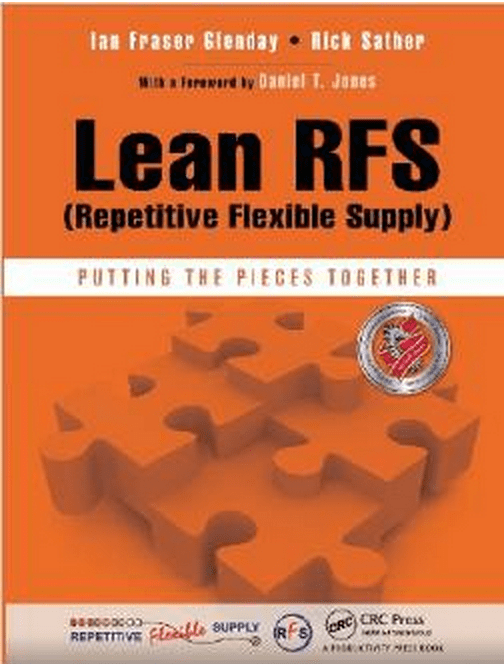
Change your production leveling strategy to achieve flow
FEATURE – Effectively applying just-in-time and achieving flow is impossible without leveling production first. Yet, most companies seem to think this is impossible because demand is so variable… but is it really?
Words: Ian Glenday, lean coach and sensei
Day in and day out, we hear that lean is all about people. I find this statement quite amusing, considering that all too often our behaviors make it almost impossible for our people to succeed.
We ask them to work just-in-time or to reduce the duration of machine changeovers, without realizing the importance of stabilizing production first: most scheduling systems are based on batch, an economic order quantity model that leads to a different production plan all the time. Additionally, we seem incapable to understand that in the minds of our employees the accomplishment of our objectives (quicker changeovers, JIT, and so on) brings no benefit to them.
Having a stable plan for production in place will highlight our number one problem: fire fighting, which is endemic and rampant in many businesses. Raising this issue suddenly creates a common enemy for everybody in the organization, and enables people to speak the same language.
I first realized there was a fundamental flaw in current planning systems in the late 1970s. Because Dan Jones and Jim Womack didn’t go to Toyota until the late 1980s, nobody knew about lean and the Toyota Production System back then.
A lot was being written, however, about just-in-time – but there was no understanding of how harmful a planning system that changes every week, and most times every day, can be to an organization.
HOW MY RESEARCH UNFOLDED
What I came to call Repetitive and Flexible Supply (RFS) is based on the idea of manufacturing the largest products in the same sequence at the same time every week. To many people, this sounds ridiculous and stupid at first.
My analysis consistently showed that, typically, 6% of a company’s products represent 50% of the volume it produces.
I started to see this happen in every factory, hospital, or office I went to. And that’s when it hit me - why not simply focus on stabilizing the plan for that 6% of the products?
At that point in time, my boss Dr Bill Walsh told me that I had to find a way to demonstrate my theory. So I ran an experiment with two teams, asking them to assemble boxes. One would do so using the traditional batch logic, the other using the principles of flow, the alternative planning logic.
Something very interesting happened during this experiment. Professor Michael Brimm, who was Professor of Organizational Behavior at INSEAD and attended the experiment, approached me and told me that what I had was not about logistics or stock, but about people and behavior.
“I have been watching the teams,” he told me. “People in the one running batches keep fighting with each other and change the numbers all the time, while suppliers don’t have a clue of what’s going on. But the other team seems to be working much better together.”
Professor Brimm told me that I’d be onto something if I could prove my theory held in real life. And sure enough, it did and we demonstrated that changing the planning system actually changed people behavior.
VARIABLE DEMAND? NOT SO MUCH
Today, many of the large organizations I work with already have a continuous improvement program in place, and decide to use RFS as a catalyst to help lean to succeed and to sustain the results achieved.
Very often, people are held back by the assumption that the demand in their organizations is highly variable, whereas most of the times it is not.
All they need to do in order to gain a proper understanding of their demand is looking at the data. What I have found is that people tend to work in “numbers of” (cases, cans, bottles, parts, you name it). They look at the unit variability, instead of the percentage variability: 5% translated in number of cases would probably sound like a very large number, but it is actually not a big percentage.
THE BENEFITS OF THE APPROACH
The first advantage of using RFS lies in the learning curve: if you do the same thing every week at the same time, you will be getting better and better at it more quickly. It’s like in a Formula 1 pit stop, where everybody knows exactly what they need to do and when they need to do it.
The second advantage is the ability to create routines: running the same products in the same sequence every week also makes standardization possible.
After routines are established, something else starts to happen: in a production environment fuelled by healthy competition, each team strives to produce the most products. I was once working in a bottling plant in the United States, in which every single Monday - after the introduction of RFS - the afternoon shift would beat the morning shift, even though every week the shifts swapped around.
There is another important difference between RFS and the traditional approach to planning production: all planning systems work on quantity, while RFS works on time, at least at first.
In a company that uses RFS, the quantity we want to produce is calculated and converted into time based on standard output. First of all, this ensures changeovers happen at the same (and best possible) time every time. Secondly, when you plan on time, quantity becomes the variable – and doesn’t this mean that you can make more in the same amount of time? Absolutely!
In a canning facility I worked with, as soon as we moved from quantity to time, production went from 850,000 cans a day to 1.2 million in only a few weeks.
Sure, running to time cannot be called ‘lean’ because it means we will need more materials available on site in order to be able to produce a larger quantity, while lean thinking urges us to only keep the right amount of materials. But at some point, when you are more reliable (variability goes down as a result of increased efficiency) and you have a more accurate idea of the window in which changeovers happen, you will be able to switch back to quantity. And you can then start to have materials delivered directly to the line, just-in-time. Something that is impossible to do with batch planning.
Finally, an additional positive effect of RFS is a boost in employee engagement and the improvement of supplier relationships due to the smaller number of changes to the plan and the lower level of fire fighting this creates. While these are difficult to measure, they often represent big issues for organizations.
Ian has authored two books.

The first one, Breaking Through to Flow, features a made-up, very simple example that shows readers how to apply RFS principles.

The second book, Lean RFS (Repetitive Flexible Supply): Putting the Pieces Together, discusses the work Ian has done with Kimberley-Clark. The company agreed to publish its RFS-related improvement activities after CEO Thomas Falk said he wanted to “put lean so deep into the business that nobody could ever take it out” and realized that a way to do so would be to document the findings.
To learn more about just-in-time and flow, demand variability, and production leveling purchase Ian’s books by clicking on the following links: Breaking Through to Flow and Lean RFS (Repetitive Flexible Supply): Putting the Pieces Together.
THE AUTHOR

Read more


INTERVIEW – Tom and Mary Poppendieck sit down with Roberto Priolo and discuss what makes product organizations successful today and where lean software development is headed.


FEATURE – This story will take you through the development of the most important A3 of Mr Joe’s life – the one meant to turn around his health and help him to live longer.


FEATURE – When it comes to the fight against climate change, we can’t expect to achieve much until we fundamentally challenge the way we think about resource consumption. Lean is our tool to do that.

